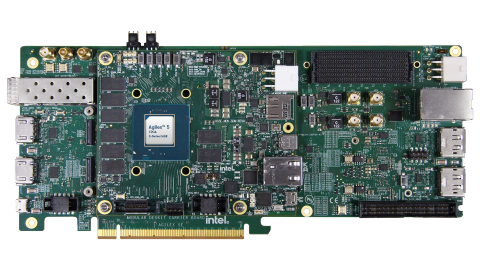What's in the Box
Powering On the Development Kit
This section will walk you through how to quickly set up your new development kit on your workstation. If you are looking for the complete documentation, please download the User Guide.
Your development kit is now ready to use.
Next Steps After Setting Up
To help demonstrate the capabilities of your Agilex 5 FPGA E-Series 065B Modular Development Kit there are a few options for you to try below.
- The Boot to Linux will walk you through taking advantage of the Hard Processor System.
- The Board Test System section will provide direction for testing the different components of your development kit.
To make full use of your development platform, it is recommended that you download the Quartus Prime Design Software before you proceed. You can find instructions on how to download and install the software here.
The Golden System Reference Design (GSRD) is a hardware and software solution designed to provide a starting point for development with the Agilex 5 FPGA E-Series HPS. Your development kit includes the HPS Expansion Board with a Micro SD card complete with Linux operating system. The configuration files for the FPGA are already flashed to its internal QSPI memory. This flow will walk you through booting the FPGA in HPS boot first mode, where the HPS will configure itself then configure the FPGA with the QSPI flash. Afterward, the Linux operating system will boot, and the user will have the ability to utilize the command line interface to work with the operating system.
1) Connect your host PC to the HPS-UART(J2) Connector on the Modular Board.
2) It is recommended that you check the MSEL Switch S4 is configured to ON-ON.
3) Go to Devices and Printers.
4) Right click on FT4232H USB UART device and go to Properties. Then select the Hardware tab.
5) Check what COM port the device occupies (IE USB Serial Port(COM4)).
6) Open the PuTTY virtual terminal software.
7) Select Serial under the Connection category from the left panel.
8) Set the configuration as follows:
- BAUD Rate: 115200
- Data: 8 bits
- Stop Bit: 1 bit
- Parity: None
- Flow Control: None
9) Click Open
10) Power on the board. You should see Linux start booting from the HPS on your Windows machine.
11) When prompted, enter root as the user. You are now signed into your Linux platform running on the Agilex 5 HPS.
12) To run a sample “hello world” program, type the following code in your terminal
cd ~/intelFPGA
then
./hello
and you should see "hello SOC FPGA” on your terminal screen
1) Plug in the Micro-USB cable to HPS-UART (J2) Connector on the Modular Board and connect to the host pc.
2) It is recommended that you check the MSEL Switch S4 is in configured to the ON-ON position.
3) Go to Devices and Printers.
4) Run the following command to determine which device the Future Technology Devices International (FTDI) driver assigns for the connection (e.g. /dev/ttyUSB0).
sudo dmesg | grep tty
5) Setup the minicom as follows:
- Ensure that minicom is installed on your system. If not, invoke the following command.
sudo apt-get install minicom
- Run minicom -s as root to enter the minicom setup mode.
sudo minicom -s
- Select Serial port setup and then press Enter.
- Press A to change Serial Device to /dev/ttyUSB0 and then press Enter.
- Press E to change the port settings. Press E again to select 115200 for Speed, and then press Q to set Data/Parity/Stop bits to 8-N-1 configuration.
- Press Enter twice to return to the main minicom setup menu.
- Select Save setup as dfl and then press Enter to save the minicom settings as defaults.
- Select Exit.
5) Power on the board. You should see Linux start booting the HPS on your windows machine.
6) After booting, enter root when prompted. You are now signed into your Linux platform running on the Agilex 5 HPS.
7) To run a sample “hello world” program, type the following code in your terminal
cd ~/intelFPGA
then
./hello
and you should see "hello SOC FPGA” on your terminal screen
The full reference document and demos can be found in the GSRD documentation.
Your development kit includes the Board Test System (BTS) graphical user interface (GUI) to test the functionality of this board. The BTS provides an easy-to-use interface to alter functional settings and observe results.
You can use the BTS to:
- test board components
- modify functional parameters
- observe performance
- measure power usage
For full instructions on how to install the necessary Java runtime environment, as well as launching the application, see the Board Test System section in the User Guide.
